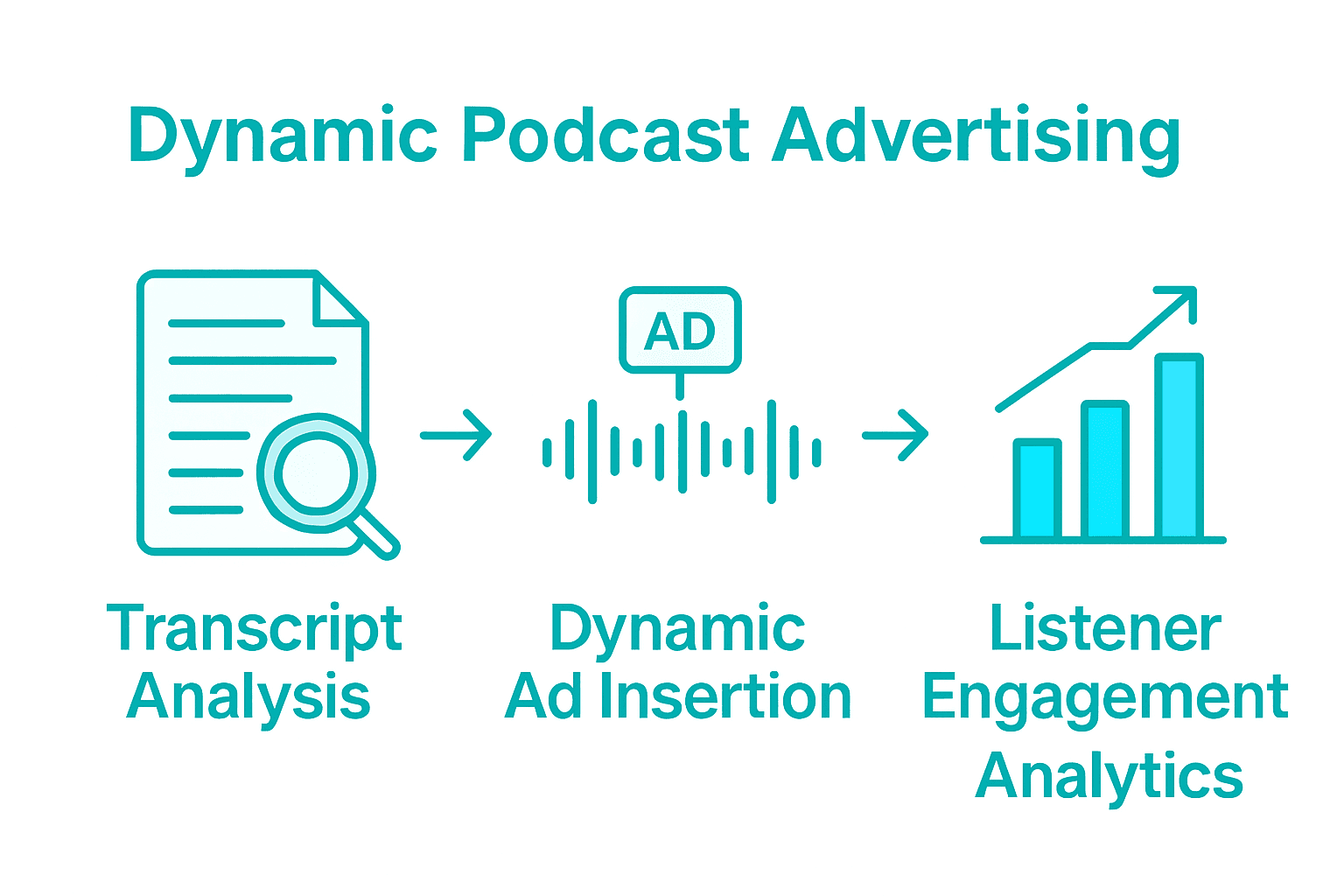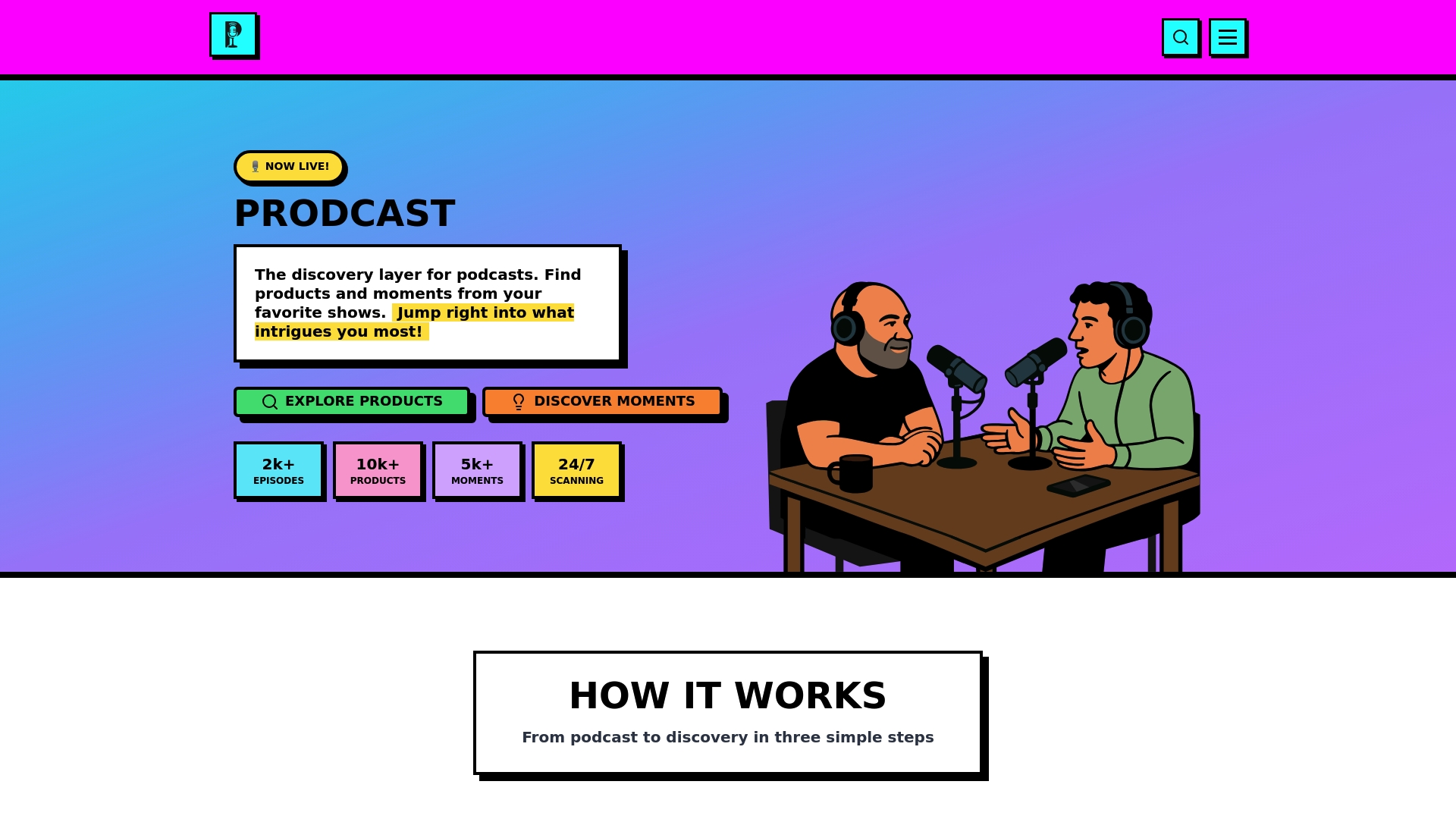CATEGORIES
TAGS
How to Use Dynamic Podcast Ads for Product Discovery

Podcast advertising has reached new heights as advanced tools reveal fresh ways to capture audience attention. Over 60 percent of listeners say they discover new brands through podcasts, making this channel a key player in product discovery. Brands looking to stand out must go beyond traditional ad placement and tap into strategic transcript analysis, dynamic ad matching, and AI-driven insights. This guide shows how to turn everyday podcast content into real marketing opportunities.
Table of Contents
- Step 1: Identify Trending Brands And Products From Podcast Transcripts
- Step 2: Select Dynamic Podcast Ad Slots Based On Listener Interest
- Step 3: Integrate Context-Driven Ads Using Ai-Powered Tools
- Step 4: Monitor Ad Performance And Adjust For Optimal Product Discovery
- Step 5: Analyze Listener Engagement And Refine Ad Targeting
Quick Summary
| Key Point | Explanation |
|---|---|
| 1. Extract brand mentions strategically | Use strategic analysis to identify product mentions in podcast transcripts and uncover consumer preferences. |
| 2. Select ad slots based on engagement | Choose podcast ad placements aligned with listener interests for increased engagement and effectiveness. |
| 3. Utilize AI for personalized ads | Leverage AI tools to create contextually relevant ads that resonate with audiences without feeling intrusive. |
| 4. Monitor ad performance closely | Systematically track metrics to optimize podcast ads and maximize listener interaction and product discovery. |
| 5. Analyze listener behavior for targeting | Deeply understand listener engagement to refine ad targeting and create personalized advertising experiences. |
Step 1: Identify trending brands and products from podcast transcripts
In this step, you will learn how to extract product and brand mentions from podcast transcripts using strategic analysis techniques. By examining podcast dialogues systematically, you can uncover valuable insights about emerging trends and consumer preferences.
According to research from aclanthology.org, podcast transcripts contain rich narrative content that can reveal specific brand and product mentions. The key is developing a strategic approach to transcript analysis. Start by selecting podcasts within your target industry or interest area. Look for shows featuring expert discussions, interviews, or review segments where product recommendations are likely to occur.
Next, scan transcripts for specific trigger words and phrases that indicate product mentions like “I recommend,” “my favorite,” “this tool changed,” or “I always use.” Pay attention to context clues that suggest genuine endorsement rather than casual references. For best results, use transcript analysis tools that can automatically flag potential product mentions and categorize them by frequency and sentiment.
Warning: Not all product mentions are created equal. A casual reference differs significantly from a strong recommendation. Focus on moments where hosts or guests provide detailed explanations about why they value a particular product.
As you collect data, organize your findings into clear categories tracking brand names, product types, discussion frequency, and perceived value. This structured approach transforms raw podcast content into actionable market intelligence that can guide purchasing decisions or marketing strategies.
Step 2: Select dynamic podcast ad slots based on listener interest
In this step, you will learn how to strategically select podcast ad slots that align with specific listener interests and maximize engagement potential. The goal is to match your ad placement with podcast segments that resonate most with your target audience.
According to dmexco.com, AI technology now enables hyper-targeted dynamic ad insertion that can precisely align advertisements with listener preferences. Begin by analyzing podcast content themes and listener demographic data. Look for moments in podcast episodes where discussions naturally connect with your product or service category. These context-rich segments offer the most receptive environment for your advertisement.
Leverage transcript analysis tools to identify high engagement segments where listeners are most attentive. As reelmind.ai explains, real-time AI matching can help brands pinpoint exact moments within podcast episodes that maximize listener interest. Focus on segments featuring expert discussions, product recommendations, or problem solving conversations that align with your brand narrative.
Warning: Not all ad slots are equally effective. Avoid interrupting critical narrative moments or emotional storytelling segments that could create listener frustration.
Prioritize ad placements that feel like natural extensions of the podcast content rather than abrupt commercial breaks. By carefully selecting dynamic ad slots that complement the listener experience, you increase the likelihood of genuine audience engagement and potential conversion.

Step 3: Integrate context-driven ads using AI-powered tools
In this step, you will learn how to leverage advanced AI technologies to create hyper-personalized podcast advertisements that seamlessly match listener interests and content context. The goal is to transform traditional advertising into a more intelligent and engaging experience.
Research from arxiv.org reveals a groundbreaking AI framework for hyper-personalized advertising that utilizes multimodal reasoning and adaptive targeting. Start by using AI tools that can analyze podcast transcript nuances, listener demographics, and content themes. These advanced systems can identify precise moments where your advertisement will feel most natural and compelling.
According to egta.com, AI-driven advertising intelligence enables unprecedented levels of ad attribution and relevance. Focus on implementing AI tools that can dynamically match ad content with specific podcast segments, ensuring your message resonates with the listener’s current context and emotional state.
Warning: While AI offers powerful targeting capabilities, maintain authenticity. Avoid overly intrusive or repetitive ad placements that might disrupt the listener’s experience.
By integrating context-driven ads through intelligent AI tools, you create a more personalized listening journey that feels less like an interruption and more like a valuable recommendation. The key is to make your advertisement feel like a natural extension of the podcast content itself.
Step 4: Monitor ad performance and adjust for optimal product discovery
In this step, you will learn how to systematically track and optimize your podcast ad performance to maximize product discovery and listener engagement. The goal is to transform raw data into actionable insights that continuously improve your advertising strategy.
According to enrollify.org, the rapidly evolving advertising landscape requires advertisers to adapt strategies based on precise performance metrics. Implement comprehensive tracking systems that capture key indicators such as listener interaction rates, conversion percentages, and time spent engaging with your advertisement. Use AI-powered analytics tools that can provide granular insights into how different audience segments respond to your podcast ads.
Research from podigee.com highlights emerging AI tools specifically designed to help podcasters optimize content and ad performance. These advanced platforms can automatically analyze listener drop off points, sentiment responses, and cross reference demographic data to help you refine your advertising approach.
Warning: Metrics can be misleading. Always consider qualitative feedback alongside quantitative data to get a complete picture of your ad performance.
By consistently monitoring and adjusting your ad strategy, you create a dynamic advertising approach that evolves with listener preferences and maximizes product discovery potential. The most successful podcast advertisers treat their campaigns as living strategies that require constant refinement and attention.

Step 5: Analyze listener engagement and refine ad targeting
In this step, you will learn how to deeply understand listener behavior and leverage sophisticated AI tools to transform raw engagement data into precise ad targeting strategies. The goal is to create a dynamic feedback loop that continuously improves your podcast advertising approach.
Research from ecommerce-podcast.com reveals advanced AI content tools designed to dissect listener engagement with unprecedented accuracy. Begin by tracking key metrics such as listener retention rates, interaction timestamps, and emotional response patterns. Pay special attention to moments where listeners pause, rewind, or skip through content, as these signals provide critical insights into their genuine interest levels.
According to supermassiveimpact.com, AI-driven podcast advertising now enables dynamic ad insertion based on granular listener data. Implement machine learning algorithms that can segment your audience into micro-groups based on listening behaviors, demographic information, and historical interaction patterns. These sophisticated tools can help you create hyperspecific ad experiences that feel less like interruptions and more like personalized recommendations.
Warning: Avoid over-segmentation. While detailed targeting is powerful, maintaining a balance between personalization and listener privacy is crucial.
By continuously analyzing and adapting your ad targeting strategies, you transform podcast advertising from a static broadcast into a responsive, intelligent conversation with your audience. The most successful advertisers view each data point as an opportunity to understand and serve their listeners better.
Unlock the Power of Dynamic Podcast Ads with AI-Driven Insights
The challenge many marketers face today is identifying the right moments in podcasts to insert dynamic ads that truly engage listeners and boost product discovery. This article highlights key pain points like choosing context-rich ad slots, leveraging AI for hyper-personalized ads, and continuously optimizing through listener engagement data. These are exactly the areas where understanding which products and brands connect with audiences is critical.
Prodcast is designed to solve these challenges by transforming thousands of podcast transcripts into clear, actionable insights about trending products and audience preferences. Our AI-powered platform helps you discover which items are genuinely recommended and when, enabling you to place ads that feel authentic and context-driven. The platform empowers marketers to track emerging trends, pinpoint ideal ad moments, and refine campaigns based on real listener behavior. Explore how Prodcast can elevate your podcast advertising strategy and turn conversations into conversions today.
Take control of your podcast ad strategy and make every placement count with data-backed insights.

Ready to discover the most talked-about products and unlock dynamic ad opportunities? Visit Prodcast now and start transforming podcast transcripts into your next marketing advantage. Dive deeper into product discovery and podcast advertising solutions at Prodcast main page and learn how to identify trending items from influencers with our AI-powered transcript analysis. The perfect ad slot is waiting for you.
Frequently Asked Questions
How can I identify the best moments for dynamic podcast ads?
To identify the best moments for dynamic podcast ads, analyze podcast content for themes that align with your product. Look for segments where hosts discuss relevant topics or offer recommendations, and prioritize these spots for your ads.
What are key metrics to track for dynamic podcast ad performance?
Key metrics to track for dynamic podcast ad performance include listener interaction rates, conversion percentages, and the time spent engaging with your advertisement. Implement tracking systems that capture this data and review it regularly to adjust strategies accordingly.
How do I use listener demographics to refine my static ad targeting?
Utilize listener demographic data to profile your target audience and tailor your ad messages accordingly. Segment your audience based on age, interests, or listening habits to create more relevant and appealing ads that resonate with them.
What steps can I take to monitor listener engagement with my ads?
Monitor listener engagement with your ads by tracking metrics such as listener retention, interaction timestamps, and emotional response patterns. Set up a system to collect this data continuously, allowing you to fine-tune your ad strategy for better results.
How often should I adjust my dynamic podcast ad strategies?
You should adjust your dynamic podcast ad strategies regularly, ideally every 30 days, based on performance data and listener feedback. Stay responsive to engagement metrics to maximize the effectiveness of your ad placements.
What tools can enhance my ability to implement context-driven ads?
To enhance your ability to implement context-driven ads, consider using AI-powered analytics tools that analyze podcast transcript nuances and match content with listener preferences. Evaluate these tools based on their capability to precisely identify effective ad placement moments.